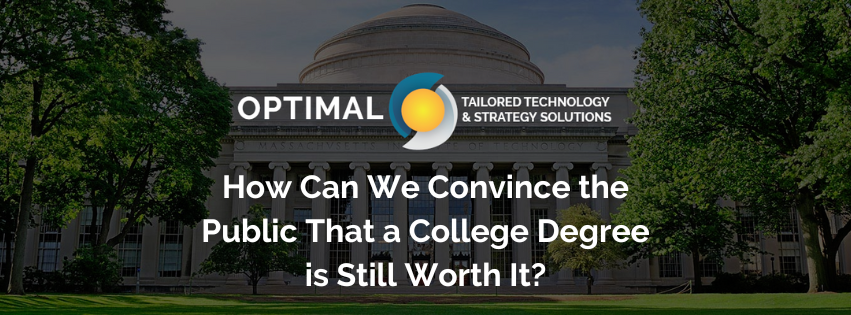 The Wall Street Journal and The Economist recently treated us to dueling perspectives on the value of higher education. The Wall Street Journal reported on a recent poll (in conjunction with NORC) revealing that 56% of Americans think a 4-year college degree is a bad bet—as recently as 2013, 53% had positive perceptions. The Economist retorted that this is not true for the average college graduate citing two perspectives which suggest that the return on the 4-year college degree remains strong. Who’s right? I suspect they both are. The key, like the devil, is in the details.
The Wall Street Journal and The Economist recently treated us to dueling perspectives on the value of higher education. The Wall Street Journal reported on a recent poll (in conjunction with NORC) revealing that 56% of Americans think a 4-year college degree is a bad bet—as recently as 2013, 53% had positive perceptions. The Economist retorted that this is not true for the average college graduate citing two perspectives which suggest that the return on the 4-year college degree remains strong. Who’s right? I suspect they both are. The key, like the devil, is in the details.
The Wall Street Journal is talking about perceptions, and it is hard to discount perceptions. Their survey says that the public perceives that higher education has lost its value. That perception is real and has consequences for institutions. This is especially important since the survey found that the most negative opinions of higher education were among 18–34-year-olds—the primary market for higher education. The Journal posits that the combination of rising tuitions, high student debt, and the pandemic are to blame. The last decade has seen a 15% decline in undergraduate enrollment. While enrollments rebounded ever so slightly this spring, there was a first-time in recent years decline in graduate enrollments. The customers of higher education perceive that there is a problem, and perceptions can lead to reality—lower enrollments.
The Economist counters that the return on investment for an undergraduate degree remains high—just slightly down from its all-time high in the early 2000s (14% vs 16%). Nonetheless, they point out that where and what a student studies makes a difference—public university graduates outperform those from private institutions and STEM majors outperform those from the humanities.
So, if the return on investment remains positive but public perceptions have turned negative, what are higher education institutions to do?
The Solution
First, colleges and universities need to take a hard look at both their communication strategies and their programming. Currently, universities are losing the public perception battle with ideological groups who argue that higher education is shaping American youth for the worse. Individual institutions can respond to this challenge, but it will take collective action from the Academy in general to win against a well-organized and well-funded movement.
Second, there is a reality to the investment perception. Too many students graduate (or fail to graduate!) with degrees in areas that will not help them succeed in the workplace. Most institutions need to analyze and revise their academic portfolios. They need to invest more in those disciplines whose majors are graduating and successful. This is not to suggest that we should eliminate all majors in the humanities. On the other hand, it is reasonable to ask all disciplines to assess the workplace outcomes of their academic programs. I am familiar with a prominent university that eliminated its computer science program when it realized that the program was not producing graduates comparable to its other programs. Furthermore, small colleges may need to partner with each other to expand their abilities to offer innovative and workplace-relevant programming. The Low-Cost Model Consortium’s shared courses and programs is a good example of such a strategy. Ultimately, mergers of individually unsustainable institutions or acquisitions of such institutions by larger institutions may be required. Arizona State University’s purchase of Thunderbird School of Global Management is an exemplar.
Similarly, I am not suggesting that private colleges should close because public institution graduates outperform theirs. Obviously, a large percentage of our prestigious and effective institutions are private. There are, however, many small privates whose students struggle to graduate and find a path to success in the workplace. To reiterate, small institutions need to take a hard look at their program portfolios. They should develop opportunities to ensure that their students can major in areas that lead to good workplace outcomes. The number of STEM majors at even the highly selective liberal arts colleges is increasing dramatically, and many of these schools are also developing programs that integrate the humanities and computer science, for example, yielding humanities graduates who compete quite well in the workplace. There are many other program integration strategies that can increase the workplace success of graduates.
These are challenging times in higher education. Attacks are coming from all fronts. Enrollment declines are serious and, because of demographic declines, are likely to continue. Despite Americans losing faith in college education, a college degree is definitely worth it. It is up to colleges and universities to tell the story loudly and convincingly and to make sure that a degree retains its value in the workplace. These are not easy tasks or easy decisions. We need to undertake them, nonetheless.
References:
Wall Street Journal, “Americans Are Losing Faith in College Education,” March 31, 2023.
The Economist, “Was Your Degree Really Worth It?”, April 3, 2023.
Avoid costly mistakes and wasted time – talk to an impartial peer in Higher Ed!
There is nothing like speaking with a peer who has implemented the same product – send us a request.
You can also provide general feedback, inquire about additional free resources, submit a topic you’d like us to cover, tell us about a feature you’d like to see, or request the best staff for your project.